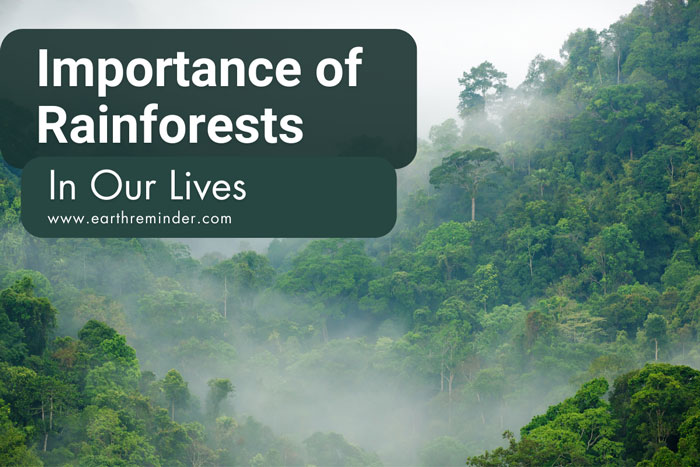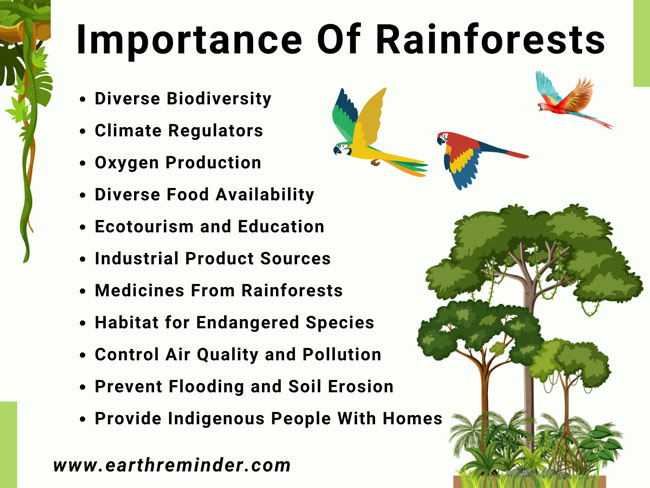Importance of Rainforests In Our Lives
The rainforest is not just a beautiful place, it is our planet’s lungs. The rainforest plays an important role in keeping our planet healthy as well as preserving the beauty of its diverse species. Nearly 6% of the earth’s surface is covered by tropical rainforests, and are a vital component of the planet’s ecosystem because they are home to nearly 50% of all plant and animal species. The rainforest gives us oxygen, controls the climate, purifies water, and keeps the air clean. A rainforest also provides millions of people with food, medicine, or other resources that make their lives easier. We need to recognize the importance of rainforests and take steps to protect them for the next generation.
Table of Contents
- 1 Introduction to Rainforests
- 2 Importance of Rainforests
- 2.1 Diverse Biodiversity
- 2.2 Rainforests Regulate Climate
- 2.3 Prevent Flooding and Soil Erosion
- 2.4 Oxygen Production
- 2.5 Diverse Food Source and Industrial Product Sources
- 2.6 Provide Indigenous People With Homes
- 2.7 Medicines From Rainforests
- 2.8 Habitat for Endangered Species
- 2.9 Ecotourism and Education
- 2.10 Rainforests Control Air Quality and Pollution
- 3 Conclusion
Introduction to Rainforests
Rainforests are tall-tree forests that see a lot of rain every year and moderately mild temperatures. The two main classifications of rainforest are temperate rainforests as well as tropical rainforests. The intertropical convergence zone, commonly known as the monsoon trough, significantly determines the essential climate change for tropical rainforests. The monsoon trough is a weather pattern near the equator where winds meet, causing lots of rain in tropical regions like rainforests. Rainforests are really precious gems of life because they are home to many species and are crucial for human survival.
Importance of Rainforests
The following are 10 reasons why rainforests are important in our lives.
Diverse Biodiversity
Rainforests are special places with a wide variety of plants and animals. They are home to about half of all the plants and animals in the world. They support a rich ecosystem where countless species live and thrive. Around 90% of the world’s invertebrates, for example, insects and spiders, live there.
The rainforest is home to everything from tiny insects to big animals. These dense forests are also home to one-third of the world’s bird species. And if we look specifically at Africa, we’ll see that the remaining rainforests in the continent hold the highest diversity of flora and fauna compared to anywhere else.
Rainforests Regulate Climate
Rainforests play a crucial role in regulating our climate. They absorb carbon dioxide, a greenhouse gas that contributes to global warming. Rainforests help fight climate change by storing carbon.
They also act as nature’s temperature and water control systems. Rainforests store water and release it when the temperature gets hot, which helps regulate the environment. They do this by taking water from underground and releasing it into the atmosphere. They are also making clouds this way. This helps maintain the water cycle, which is important for our climate. When we cut down rainforests, we disrupt this cycle. This can lead to less water in the air, which increases the risk of drought. If this continues continuously, we will see our beautiful forests turning into dry deserts.
Prevent Flooding and Soil Erosion
Rainforests can prevent erosion and flooding in the following ways:
Canopy and Tree Roots
Rainforests are covered with a dense canopy of tall trees that slow down rainfall, making it less damaging to the ground. The canopy is the part of the forest above ground that is made up of trees. Forest trees overlap their leaves and branches to make the canopy layer. This means the forest floor has more time to absorb water because water doesn’t hit the ground directly. This also reduces soil erosion. The roots of rainforest trees also bind the soil together, preventing erosion during heavy rains.
Absorption and Water Storage
Plants, trees, and grasses absorb and hold water in rainforests. The roots of these plants act like sponges, absorbing water from the soil. Their capacity to store water prevents it from flowing directly into rivers, which prevents flooding. This also minimizes soil erosion by reducing water flow over the soil surface. The deep, porous soil structure also absorbs water and reduces runoff.
Evapotranspiration
Rainforests have a high rate of evaporation and transpiration. Evaporation is when water turns into vapor on surfaces like leaves and soil. The process of transpiration occurs when plants release water vapor through tiny openings in their leaves. Evapotranspiration is a combination of these processes that helps regulate the water cycle by returning moisture to the atmosphere. This reduces the overall volume of water reaching rivers and streams. This process also helps maintain soil moisture levels. It enhances soil cohesiveness as well as stability, and reduces soil erosion risk.
Oxygen Production
The rainforests are known as the “lungs of the earth” because they produce a significant amount of oxygen through a process called photosynthesis. Rainforest trees and plants absorb carbon dioxide and release oxygen. The Amazon rainforest specifically absorbs 25% of the CO2 absorbed by all land on the globe, but this number has decreased by 30% in the past few decades due to deforestation. We need to protect rainforests because all living organisms, including humans, depend on oxygen to breathe and survive.
Diverse Food Source and Industrial Product Sources
- Diverse Food Sources: Nuts and fruits are plentiful in rainforests. There are bananas, mangoes, and pineapples, as well as cashews and Brazil nuts. Rainforests are the source of spices and flavorings such as black pepper, cloves, cinnamon, and cardamom. Some rainforest plants also produce edible oils, such as palm oil and coconut oil that can be used in cooking.
- Industrial Product Sources: Rainforests have many types of trees that provide timber for furniture, houses, and paper. Some rainforest plants have strong fibers that are used to make textiles like ropes and bags. Natural rubber comes from rubber trees, for example, the Pará rubber tree in rainforests, which are used for tires, shoes, and gloves.
Provide Indigenous People With Homes
Rainforests provide indigenous people with a home that is important to their culture. They depend on the rainforests for food, medicine, and materials, and they have special knowledge about the plants and animals there.
The forests also bring them together as a community. They give indigenous communities a physical and cultural space to connect. The importance of rainforests is even greater since people consider these forests sacred and recognize their great cultural significance.
We need to understand that indigenous people in rainforest areas have a lot of problems from outside their communities, like deforestation, taking their land, and using up resources. It can hurt their quality of life, their culture, and their overall happiness. We have to respect their rights, give them ownership of their land, and value their knowledge and traditions to save the rainforest.
Medicines From Rainforests
Rainforests consist of many medicinal plants. They can provide natural remedies for various medical conditions, like the Wasai for kidney health, rosy periwinkle for leukemia treatment, and cinchona tree for treating malaria.
We can see the importance of rainforests for Western medicine because they are home to diverse plants and animals with valuable medicinal properties. These resources have contributed to the development of drugs for illnesses like cancer and malaria. We need to protect rainforests for future medical discoveries and our health.
Habitat for Endangered Species
Many endangered and threatened species live in rainforests. Ecosystems provide shelter, food, and habitat for wildlife. We need to protect rainforests to protect endangered species and ensure biodiversity will be preserved for future generations.
Ecotourism and Education
Rainforests offer educational and cultural experiences to visitors through ecotourism. Visitors can get a deeper understanding of rainforest ecosystems, learn about rainforest conservation, and explore the beauty of these ecosystems. Local communities also benefit economically from ecotourism initiatives, which encourage a sense of responsibility and increase environmental awareness.
Rainforests Control Air Quality and Pollution
Rainforests clean the air and regulate it. They clean the air by absorbing pollutants and filtering harmful particulate matter. Forests reduce pollution, which helps humans and wildlife live in healthier environments.
Also Read: What Happens If the Amazon Rainforest Disappears?
Conclusion
Rainforests are extremely important in our lives. Our world’s health and our quality of life both depend on rainforests. They regulate the climate, support various plants and animals, and give us valuable resources. They’re home to millions of species, some of which are still unexplored. They supply resources necessary for human survival, including food, medicine, and wood. Rainforests are the Earth’s lungs, absorbing CO2 and producing oxygen, which helps fight climate change. Rainforests also provide work to many people around the world through ecotourism and sustainable resource extraction. We need to preserve rainforests for the health of our planet, wildlife, and ourselves.

